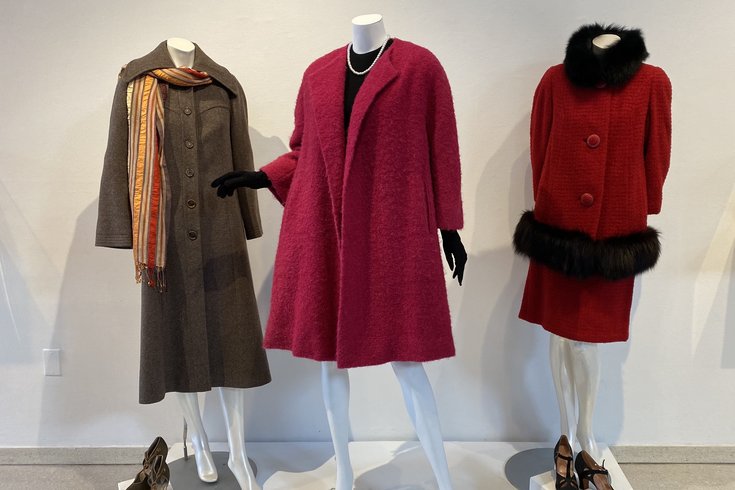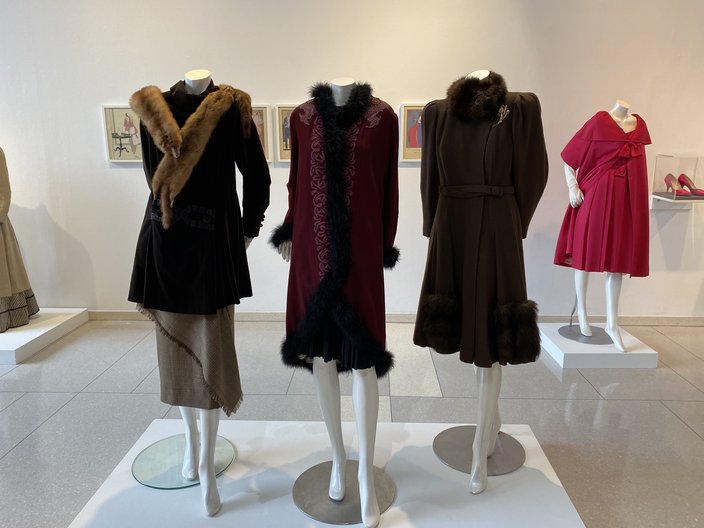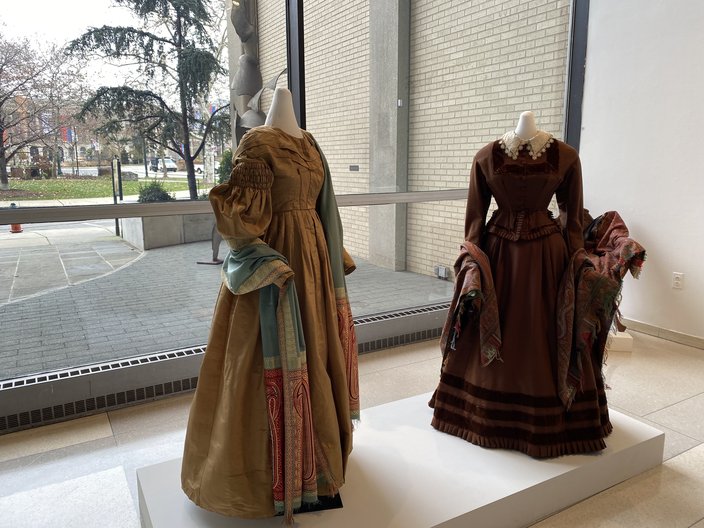
December 07, 2023
 Kristin Hunt/PhillyVoice
Kristin Hunt/PhillyVoice
These '60s era coats are just a few of the women's winter wear items on display at the Moore College of Art & Design through Jan. 6.
Right behind the reception desk at the Moore College of Art & Design stand a fleet of headless mannequins in ruffled, fur-lined and hand-stitched coats and dresses — some dating back to the 1820s.
The outfits come from the college's historic costume collection and are part of an ongoing exhibit called "Bundle Up! Outerwear from the 19th-20th Centuries." Curated by alum Jane Young-Likens and graduating senior Arianna Baback, the display shows the progression of women's winter wear over nearly two centuries, starting in the time of the industrial revolution and ending around the Clinton administration.
The oldest piece in the exhibit existed even before the women's college, which was founded in 1848. The full-length silk dress was hand-sewn and hand-dyed in 1829, and is styled with a shawl featuring a paisley pattern.
It stands next to a dress made only about 50 years later, but with the help of aniline dyes and sewing machines introduced in the intervening decades. This dress, too, has a paisley shawl draped over it, signifying the immense popularity of these garments in the 1800s.
Originating in Kasmir, India, the shawls were made with wool from cashmere and pashmina goats and popularized by Josephine Bonaparte, who flaunted them as a status symbol. With the help of mechanized looms, towns like Paisley, Scotland, began mass producing their own versions for the European and American markets.
A pair of dresses dating back to the 19th century. The dress on the left was created by hand in 1829, before the advent of the sewing machine. The dress on the right was manufactured in the 1870s.
As the fashion timeline progresses, visitors can see a faux seal jacket, a long "walking skirt" and a duster linen coat designed to protect women's dresses from the dirt kicked up by early automobiles. A bright reddish-pink coat from 1908 was made either for or by John Wanamaker's pioneering Philadelphia department store, which now houses Macy's.
Coat hemlines started hiking after World War I because women had to work and World War II rations limited how much fabric designers could claim for their outerwear, Young-Likens said. Fur was still very much en vogue, as evidenced by the fur scarf and trimming on two coats in the exhibit. A third has marabou feathers.
"We took a little chance to put the skins up," Young-Likens said. "I thought people may not like that. (But) I wanted to show how fur was so common in these cultures and yet most modern pieces avoid it."
A trio of coats from World Wars I and II, featuring fur and feather trimming or accessories.
Moving into the '60s, "the color palette got really bright and really fun," Young-Likens said. The trend toward shorter and less cumbersome women's clothing continued, as seen in the increasingly cropped car coats favored by suburban moms.
"That's pivotal, in terms of silhouettes, to have a jacket," Young-Likens explained. "This was really for practical purposes, and it was very popular. ...This idea of things getting more tailored, less feminine and more cut, I think, is really important."
The exhibit also includes a brown wool coat purchased at the Philadelphia Craft Show, a wide array of hats and a pair of spats with a button hook that would have been used to secure the accessory, which guarded shoes from splatter. Framed fashion plates line the walls, providing a glimpse into fads like Japonisme, the intense interest in Japanese style that followed the country's emergence from 200 years of seclusion.
The exhibit is open Mondays through Saturdays from 11 a.m. to 5 p.m. at the Galleries at Moore at 1916 Race St. It will remain on view until Dec. 16, when it will close during the college's winter break. It briefly will be accessible again Jan. 2 through Jan. 6, when it shutters for good to make way for the next display.
Follow Kristin & PhillyVoice on Twitter: @kristin_hunt
| @thePhillyVoice
Like us on Facebook: PhillyVoice
Have a news tip? Let us know.
 Kristin Hunt/PhillyVoice
Kristin Hunt/PhillyVoice